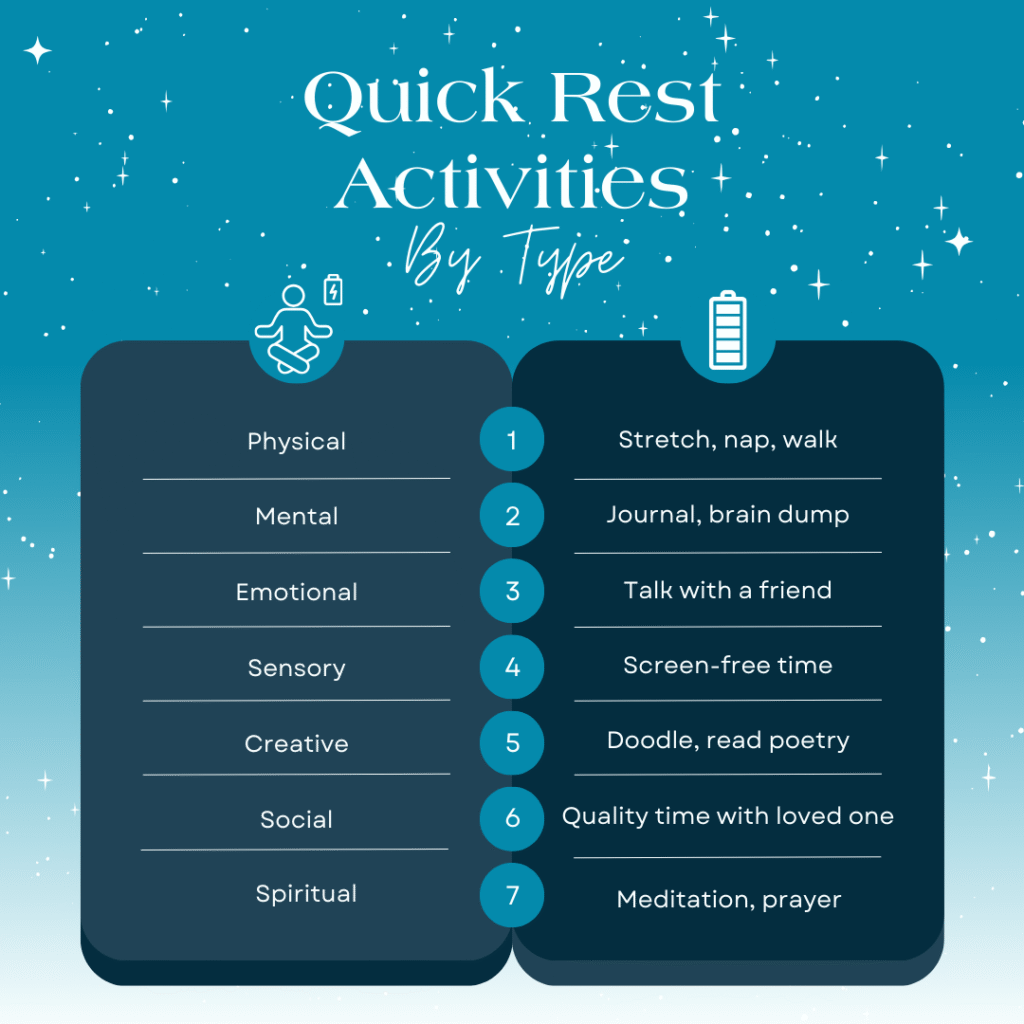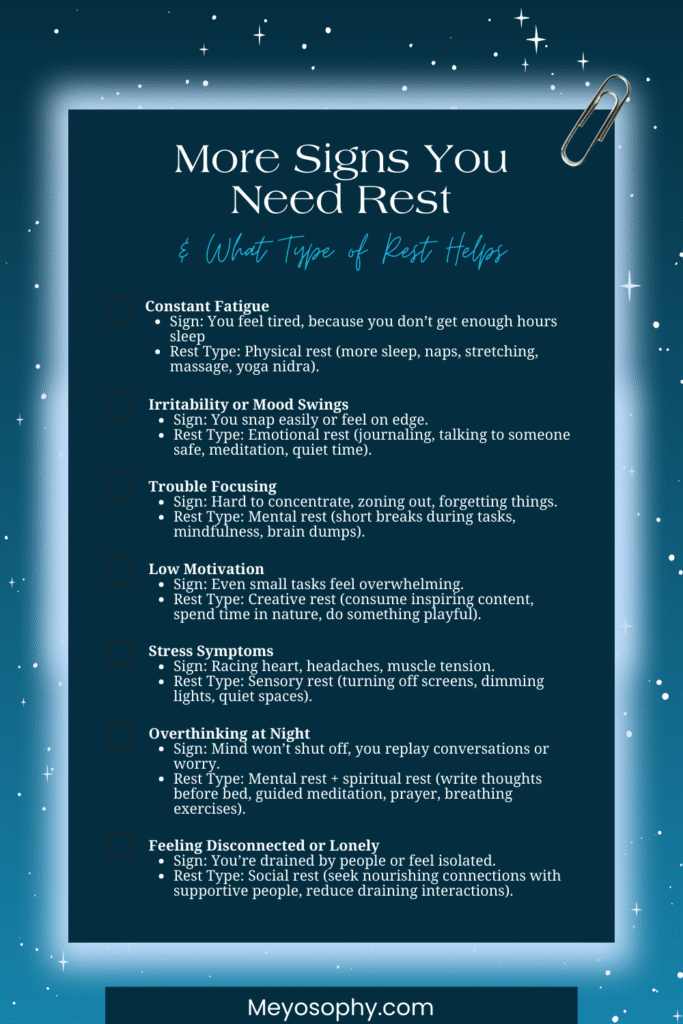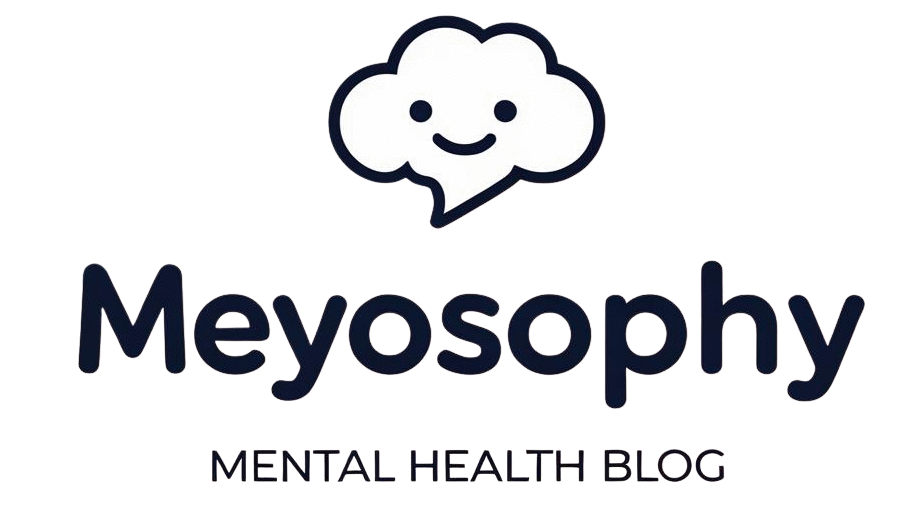Why Rest Deserves a Plan
Most of us carefully plan our workdays, our fitness routines, even our meals. When it comes to rest, we often just “fit it in when there’s time.” The problem? That time rarely comes. Without intention, rest becomes the first thing to drop off the calendar, replaced by endless to-do lists and digital distractions.
But here’s the truth: rest isn’t optional, it’s essential (ask anyone who’s had a burn-out). Just like sleep, food, and movement, rest is a basic human need. It recharges our mind, body, and emotions, helping us live with more clarity, focus and joy.
A personal rest plan is a structured but flexible approach to making rest a priority in your life. Instead of treating it as an afterthought, you actively schedule and design rest to match your needs. In this guide, we’ll explore the different types of rest, how to schedule them and how to protect your rest with clear boundaries. I know many people struggle with prioritizing this, but just implementing a few changes can make a big difference.
Step 1: Understand the 7 Types of Rest
When people hear “rest,” they often think of sleep. But research (especially by Dr. Saundra Dalton-Smith) shows there are seven types of rest we all need. A personal rest plan begins with identifying which areas of your life feel depleted.
- Physical Rest – Sleep, naps, stretching, gentle movement, massage.
- Mental Rest – Taking breaks from problem-solving, daydreaming, journaling.
- Sensory Rest – Reducing screen time, noise, bright lights, or clutter.
- Creative Rest – Stepping away from problem-solving to experience art, nature, or play.
- Emotional Rest – Expressing feelings openly, journaling, or seeking support without judgment.
- Social Rest – Choosing relationships that uplift you and limiting draining interactions.
- Spiritual Rest – Connecting with meaning, values, or practices like prayer, meditation, or mindfulness.
👉 Action: Write down which areas feel most “overdrawn” for you. For example, if you always feel overstimulated by screens, sensory rest might need to be central in your personal rest plan.

Step 2: Identify Your Rest Needs
Not everyone needs the same type or amount of rest. For example:
- A parent of young children may desperately need physical and mental rest.
- A creative professional might need more creative and sensory rest.
- Someone working in customer service might crave emotional and social rest.
Journal prompt:
- When do I feel most drained during the week?
- Which of the seven types of rest do I rarely make time for?
- What small rest activities genuinely restore me?
By mapping your personal rest “gaps,” you can design a plan that targets the areas where you need it most.
Step 3: Build Your Personal Rest Toolkit
Your toolkit should include simple, practical activities that you can draw on daily. Here are examples for each type of rest:
- Physical Rest: 20-minute nap, yoga stretches, walking barefoot on grass.
- Mental Rest: 5 minutes of mindful breathing, writing down tasks before bed.
- Sensory Rest: Noise-cancelling headphones, digital detox evenings.
- Creative Rest: Coloring, listening to music, a walk in nature without your phone.
- Emotional Rest: Talking to a trusted friend, therapy, journaling feelings.
- Social Rest: Coffee with an uplifting friend, saying “no” to draining events.
- Spiritual Rest: Meditation, gratitude journaling, attending a spiritual service.
👉 Tip: Choose 2–3 activities per category so you always have options.
Step 4: Schedule Rest Intentionally
Rest doesn’t happen by accident. To make it part of your lifestyle, you need to schedule it with the same importance as work or appointments.
Here are three ways to structure it in your personal rest plan:
Daily Rest Moments
- Example: 10 minutes of stretching after waking, 15 minutes of digital detox before bed.
- Small but consistent breaks help prevent burnout.
Weekly Rest Blocks
- Example: Sunday mornings as “screen-free nature walks” or Friday evenings reserved for creative hobbies.
- These longer blocks let you go deeper into rest.

Seasonal/Monthly Rest Rituals
- Example: A weekend retreat, a day of silence, or a quarterly “reset” where you reflect on your energy. These restore your bigger picture balance.
👉 Pro tip: Time-block rest directly in your digital calendar. If you don’t schedule it, it will get squeezed out.
Step 5: Protect Your Rest with Boundaries
Creating a personal rest plan is only half the work, the other half is protecting it. Boundaries make sure your rest time isn’t overtaken by work, notifications, or other people.
Here’s how to safeguard your rest:
- Set digital boundaries: Turn off non-essential notifications, use “do not disturb” mode during rest.
- Communicate clearly: Let others know you’re unavailable during your rest time.
- Say no more often: Decline commitments that drain your energy or clash with your rest plan.
- Create a restful environment: Declutter your space, add calming elements like plants, candles, or soft music.
👉 Script for saying no: “I’d love to help, but I’m prioritizing rest this week. Can we revisit this another time?”
Step 6: Adjust and Personalize as You Go
A rest plan isn’t static, it’s a living system that evolves with your life. What works during a stressful work season may differ from what restores you during a vacation.
Ask yourself monthly:
- Which rest activities actually replenish me?
- Which ones feel forced or unhelpful?
- Do I need more of one type of rest right now?
Your rest plan should feel supportive, not like another obligation (we have enough of those).

Step 7: Track the Benefits
If you’re skeptical about taking time for rest, tracking the outcomes can help you see its value. Pay attention to:
- Energy levels: Do you feel less fatigued throughout the day?
- Focus: Are you more productive and clear-headed at work?
- Mood: Do you feel calmer and less reactive?
- Sleep quality: Are you falling asleep easier or waking more refreshed?
👉 Optional tool: Keep a simple “rest journal” where you write down what rest you practiced and how you felt afterward.
Conclusion: Designing Rest Is Designing a Better Life
We live in a world that glorifies busyness. But true resilience, focus, and creativity come from intentional rest. By creating a personal rest plan, you’re giving yourself permission to recharge in ways that matter most to you.
Think of it as a compass for your well-being: guiding you back to balance when life feels overwhelming. Start small, stay consistent and adjust along the way. Your body, mind and soul will thank you.
Disclaimer: I’m not a mental health professional, everything here is shared from research and personal experience. If you’re feeling overwhelmed or need support, please consider talking to a qualified professional. You’re not alone. If you’re in the U.S., you can call or text 988 anytime. For help in other countries, visit https://findahelpline.com. Read more about our disclaimer here.
Rest is what fuels productivity and creativity, it’s an investment, not a waste.
Without planning, rest rarely happens. A rest plan ensures it becomes a priority.
Sleep is essential, but emotional, social and creative rest are equally important for balance.


One thought on “Creating a Personal ‘Rest Plan’: Why You Need One”